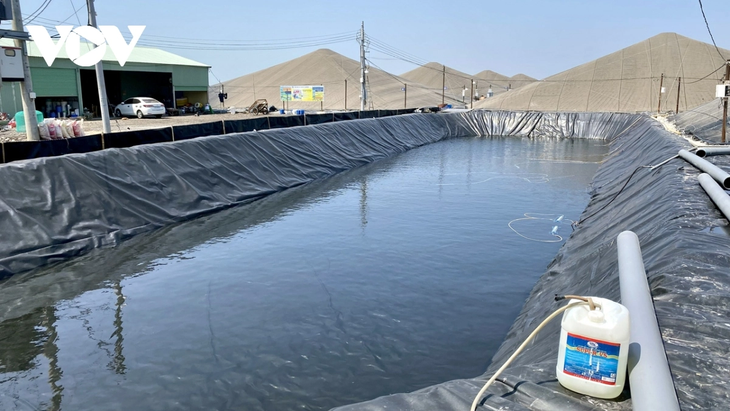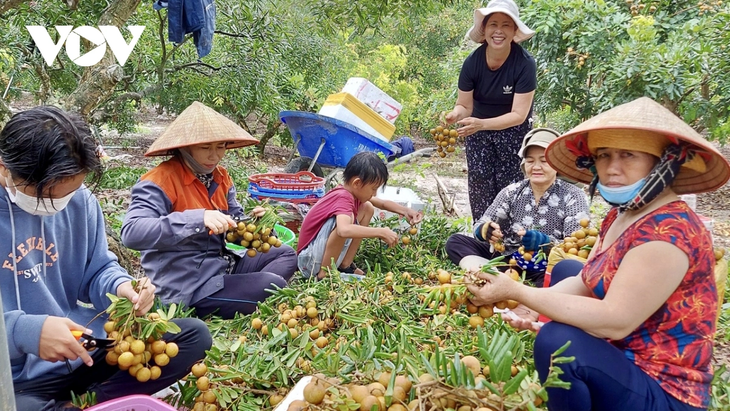(VOVWORLD) - High-tech agriculture is identified as one of four economic pillars of Ba Ria-Vung Tau in line with the Resolution of the provincial Party Committee for the 2020-2025 tenure. Despite impacts from climate change and challenges from integration, the province has followed the set orientation, achieved initial results, and promoted the role of high-tech agriculture in its development.
 The high-tech shrimp farming model at Cho Ben Cooperative in Long Dien ditrict (Photo: Gia Khang) The high-tech shrimp farming model at Cho Ben Cooperative in Long Dien ditrict (Photo: Gia Khang) |
Established in 2002, the Xuan Truong Agricultural Cooperative in Binh Ba commune, Chau Duc district, has 12 hectares of dragon fruit. The Cooperative has encouraged its members to apply the VietGap and Global Gap standards to bolster sales.
By 2021, to satisfy the strict import requirements of countries like the US, the Xuan Truong Cooperative worked with other cooperatives in the region to get farmers to follow organic standards and participate in the OCOP program to guarantee themselves a stable income.
Trinh Van Tien, a member of the Xuan Truong Cooperative, said that cooperative members have been working with each other to produce dragon fruit for the market and are reducing pesticide use and using biological fertilizers to avoid using too many chemicals.
“We have 4 growing areas, each producing 4 tons of fruit. Prices are stable right now, and we’re making bigger profits than when we were growing peppers,” said Tien.
With Ba Ria-Vung Tau’s support for high-tech agriculture, Dong Nai province’s Long Thanh Phat High-tech Agricultural Cooperative in Hoa Hoi commune, Xuyen Moc district, Ba Ria-Vung Tau province, has invested 3.3 million USD in raising chickens for export.
The Cooperative, which has raised from 180,000 to 240,000 chickens in an enclosed 1.2-hectare space, uses an automatic cooling system and controls to prevent outside pathogens and diseases from infecting the chickens.
Le Van Quyet, President and Director of the Long Thanh Phat Cooperative, said that, thanks to high-tech, their loss rate is low and productivity is triple that of the conventional farming model.
The Cooperative's products have been exported to Japan, earning 2 million USD per year.
“This method is very good for the environment, productivity is high, and most importantly, the chickens are healthy,” said Quyet, adding, “We control the microclimate in the barn. That means we can meet the needs of the chickens at each life stage so the chickens are healthier and more productive.”
 Harvesting longan in Dat Do district (Photo: Gia Khang) Harvesting longan in Dat Do district (Photo: Gia Khang) |
Ba Ria-Vung Tau province has attracted 484 high-tech agriculture businesses, investors, organizations, and individuals, including 342 crop businesses, 127 livestock farms, and 17 fishery farms.
Chau Duc district was chosen to pilot a high-tech agricultural production initiative. To date, high-tech products account for 40% of the locality’s economic structure value.
Nguyen Tan Ban, Chairman of the district People's Committee, said that, to increase the value of agricultural products and improve farmers’ income, the district is encouraging clean production: raising pigs in air-conditioned barns and avoiding chemicals.
Ban said, “Chau Duc will focus on high-tech agricultural production in the direction of value chain links and exports to increase value per area unit. This will help farmers make a profit on 8,000 hectares of agricultural land in the district.”
According to Le Thi Trang Dai, Chairwoman of the Xuyen Moc district People's Committee, before tourism developed, Xuyen Moc was a completely agricultural district.
Since the provincial Party Committee promulgated Resolution 9 on planning high-tech agricultural production areas to grow rubber, peppers, and fruit trees from 2020 to 2025, local products have built a brand reputation.
“Xuyen Moc district has planned the application of high-tech to enable models and cooperatives to cover all the outputs. Many agricultural production models in Xuyen Moc follow VietGap standards in producing Nhan Tam longans, Bau May peppers, and noni fruit juice,” said Dai.
Ba Ria-Vung Tau’s Department of Agriculture and Rural Development said the provincial Party Committee’s Project 4 to develop high-tech agriculture between 2020 and 2025 has boosted the agriculture and rural development sector.
The average value of high-tech agricultural products has reached 4,600 USD per hectare, up 570 USD since 2015.
Ba Ria-Vung Tau has set a target of high-tech agriculture accounting for 50% of all agricultural production by 2025 and at least 10 regions and 5 high-tech agricultural enterprises. All the area planned for high-tech agricultural development will be recovered to implement production projects.
To achieve these targets, Ba Ria-Vung Tau will continue to effectively promote high-tech application models, contributing to the development of sustainable agricultural production and bringing benefits to cooperatives, businesses and farmers.